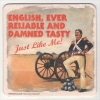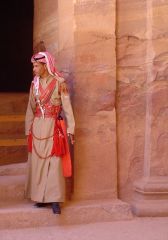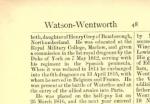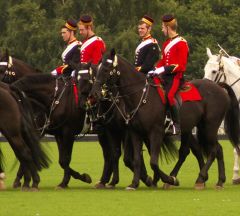-
Posts
230 -
Joined
-
Last visited
Content Type
Profiles
Forums
Blogs
Gallery
Events
Store
Everything posted by Owen
-

Lt. Colonel J.A.Balfour OBE, RE
Owen replied to Mervyn Mitton's topic in Great Britain: Orders, Gallantry, Campaign Medals
Wow! To have the medals and the diary is very special. It seems that we mostly we have to rely on the bare bones of long and involved research (with only lucky/rare glimpses into contemporary personal thoughts/feelings/context)...meaning that we usually have to guess about the 'emotive' stuff. I have enjoyed reading through this thread - you get a real sense of the man and the time. Owen -
Thought I would share another item from my collection. A rare surviving piece of Wellingtonian ephemera, from the first half of the 19th century - a hand coloured ticket (circa 1841), to see 'The Waterloo Banquet' painting, when it was first displayed, at Apsley House, home of the 1st Duke of Wellington, in 1841: Every year after 1815, on the anniversary of the battle of Waterloo, the Duke of Wellington hosted a 'Waterloo Banquet', at Apsley House. This banquet was effectively a reunion of the principal officers who fought at Waterloo, Quatre Bras and Ligny. The banquet is still held, every year. In 1836, to mark the attendance of King William IV (seated on the right of Wellington), William Salter was invited to paint this banquet. When finished, 'The Waterloo Banquet' was "exhibited to wide acclaim. In fact, the demand to see it was so great that tickets were issued. One reviewer noted… it is a great national picture, and its interest is enhanced when we consider how soon the illustrious characters before us will exist only as historical celebrities, and their place among men be found alone in the breathing canvas of Mr Salter”. The painting is still on display at Apsley House. To help compose the scene, Salter chose the moment when Wellington rose for a toast...at which time "the rules of etiquette meant that diners could arrange themselves in small clusters and move away from the initial place settings, thus allowing Salter to paint all the sitters from recognizable angles. Aside from Wellington and William IV, the sitters include; Earl Bathurst (posthumously included), the King of Holland (on Wellington’s right), the 4th Duke of Richmond (host of the famous ball before Quatre Bras), Lord Vivian (commander of Light Dragoons cavalry brigades), Major-General Sir Peregrine Maitland (commander of the 1st Brigade of Guards), and Lord Hill (a survivor of the fierce fighting, despite having his horse shot from under him)". The entry ticket to Apsley House is signed by F.G. Moon (of 20 Threadneedle Street, London), an engraver and printer, by Royal Appointment. As a footnote, Moon was given sole permission, by Wellington, to manage a run of official engravings of the painting. As part of an advert, placed in the "Athenaeum" in August 1839 (2 years before Salter finished the painting), Mr Moon cautioned: It would seem that Mr Moon & Mr Salter were working in very close cooperation over the 'Waterloo Banquet' project. The picture of the painting and some of the background information on it is from Philip Mould's website: http://www.historica...-William-Salter
-
-

What Could it Be? (circa 18th C German Hunting Flask?)
Owen replied to Owen's topic in Non Military Collectibles & Antiques
Thanks Mervyn - I see it now! Interesting observation on the chain too, I simply hadn't considered that. I guess it is possible that the chain was replaced or perhaps it was added to an item that did not originally have a chain. All in all, I am very pleased that I posted it...you have given me quite a bit to think on. I have always hoped to see something similar, but never have. As you say, the guessing and speculation is part of the fun (sometimes the truth, when finally revealed can be more disappointing!). I might start to think of it as a cartridge case rather than a flask...Owen -

What Could it Be? (circa 18th C German Hunting Flask?)
Owen replied to Owen's topic in Non Military Collectibles & Antiques
Oh dear, I'm feeling like I normally do after not being able to answer a single correct question on 'University Challenge'! I have looked at the vases of flowers and can see that there are differences, but nothing about either one shouts man or woman to me...I must admit though that I have not looked in detail at the vases and now that I do...I wonder if they are supposed to be ducal style coronets? I have always thought the chain was original...it is heavy/chunky and feels right....but, now that you have raised the possibility it isn't...I will have a closer look at it tomorrow. Thanks for commenting - it is great to see something through fresh eyes and I am very interested in your thoughts on what it might be. I particularly like the thought of early cartridges...this would certainly have kept the powder dry. -
Thanks Mervyn...I have been thinking the same for a while. I did put my name on the 'About Me' part of my profile, but I don't know how to change from Monkey to 'Owen'!? With regard to the Christmas cards, I had not thought of them in terms of having a particular monetary value. Something to consider, but I would find it hard to sell the 'Split A' card (sentimental value is too high). Thanks for your comments though - especially the 'familiy' one....I have to say that I enjoy spending time with you all. The TVR Car Club forum is wondering where I have disappeared to!
-
As part of a long promised/long overdue Spring clean, I have been sorting through some of my 'stuff'...stuff that has long been consigned to boxes in the attic etc. Anyway, I have unearthed items that I had almost forgotten about...and it has been quite a trip down memory lane as some were given to me/acquired when a boy back in the late 60's/early 70's. I will share some of the items (I have posted an Arbeitsbuch in the German Signatures area already). This post is about two WW1 Christmas Cards. They were both given to me as a boy by my piano teacher and neighbour back in about 1967/8 - Mrs Edith Solano was the elderly widow of an Officer who had served in the Indian army. I was like a Magpie (even then) and the cards went into 'my tin of special things'. There they sat, being moved from attic to attic as I grew up and we moved around. They came to light about 3 years ago when my mother moved house and had a clear out of her attic! Only then did I try to find out a little about old Mrs Solano's officer husband - 2nd Lt...Lt...Capt...Maj...Lt Col Bernard Austin Solano of the 46th Punjabis (late of the Worcestershire Regt). First, his Christmas card to Edith: At the time of writing this card he would have been a Brigade Major with the 18th Infantry - part of the Egyptian Expeditionary Force - with General Allenby being the Commander in Chief. This is a period of history I know very little about, but (having served myself in and around Lebanon, Syria, Jordan and Palestine) I am aware that Allenby, the Arab Revolt and Lawrence of Arabia were significantly inter-connected (excuse my ignorence for those who know something of this period)....I note that the card depicts Jerusalem & Jordan in the background. In 1919, Capt Solano (he had been an Acting Major) was mentioned in Allenby's despatches: I feel that there is a lot that the card is telling me, including the handwritten message, but it remains a bit cryptic to me (the Split A thing)...maybe it makes good sense to some of you? Bernard Solano was Commissioned out of Sanhurst, as a 2nd Lt, in 1906 (into the Worcestershire Regiment). He was promoted to full Lt in 1909 and transferred to the Indian Army (46th Punjabis). He remained with the Indian Army and retired, as a Lt Colonel, in 1933. He died in 1940. His WW1 medal card is here: I feel that there is a lot to learn about this officer and I wish I could go back and talk to his widow (little did I know, aged 8, what it meant to her to give me the cards). This brings me to the 2nd Christmas Card. This is not from Bernard (signed from'Uncle Bill') and sadly, I don't know anything about 'Uncle Bill':
-
German militaria etc is outside my collecting area, but I have had an 'Arbeitsbuch' since I was a young boy, back in the early 1970's...I think it came from my Dad (who left us in 1970)....perhaps he picked it up while we were based in Germany in the mid 1960's (I can't think where else it might have come from). It certainly isn't from any family connection. It has just been sitting in a box of papers for years. There are some Organisation Todt stamps/signatures and a bit googling tells me that they were quite an interesting organisation..anyway, over to you - hopefully it will be of some help with your project...(apologies if it is not of interest/help)...
-

Off with his Whiskers!
Owen replied to Owen's topic in Great Britain: Research, Documentation & History
Agree Chris...I'm sure that the court marshal records of the day would make interesting reading....as young 'Private Whiskers Malone' tried to defend his position! Mind you, my first RSM was quite clear about hair length...still, it has helped ease the pain of male pattern baldness! Despite the views of His Majesty in 1837....clearly, things had slipped a little by 1856! Found on British Battles.com: http://www.britishba.../sevastopol.htm Reminds me of a story that my better half's cousin told me recently. He is a former Army Dentist....and, while serving in Germany, he took a call from the Garrison RSM (who, for some time, had been gently reminding him to visit the barber)...the RSM told him that there was no queue at the barber shop, so it might be a good time to pop round there. After a few seconds of thought, Dentist cousin told the RSM that this was a cooincidence as neither was there a queue at his dental surgery...so, it might be a good time for the RSM to pop round for his long overdue dental check-up! -
Clearly, in 1837, the King was in no mood for long hair and whiskers... Circular is signed by the then Adjutant General, Lt General Sir John MacDonald, a known disciplinarian and veteran of the Peninsular Wars.
-
Peter, many thanks for taking the time to comment, I'm pleased you find it interesting and I do agree with you about Wiki. Two of their reference sources are below (and it is clear where the confusion about his presence at Waterloo arises). In many ways, as I am still a 'new boy' with regard to medal etc research, this is all good practice. I am learning, as I go, just what sort of reference material is out there and how to access it. Source: The 'Dictionary of National Biography' (Volume 60, Page 47). This dictionary apparently still serves academic institutions as a standard work of reference on key people in British history (originally published in 63 volumes between 1885 and 1900). I have checked Watson's full biography entry in the 1899 version and it records him as being at Waterloo (following is an extract from the full biography) "He was present at the Battle of Waterloo and at the entry of the allied armies into Paris" (word for word as it appears in the Wiki entry). Of course, it doesn't actually state that he was at Waterloo with his own Regiment...perhaps he was detached? Source: Watson's obituary also appears in 'The Gentleman's Magazine' (January to June edition of 1860) and it talks of him having served with the 6th Dragoons in Belgium & France in 1815 (it does not mention Waterloo): At the moment then, according to the Army List - he transferred back to the Colours (full pay list) of 6th Dragoons, in April 1815, and then returned to the half pay list (almost a year later), in March 1816. April 1815 would have been the time that his Regiment were ramping up to meet Napoleon head on and so it seems likely that he did go to Belgium with them and then on to France (many regiments were returning to England from France about this time in 1816). However, I have checked (online) the 6th Dragoon''s original manuscript Waterloo Medal muster lists & their Waterloo Medal Roll (held at the National Archives) and he is not listed as being at Waterloo with them. I feel that the omission of 'Waterloo' from his headstone, whilst mentioning Belgium, is significant. Clearly, I need to get to the National Archives in person and have a look at what they have for Watson's service with the 6th Dragoons. But this will have to be a 'rainy day' job. Thanks again for the encouragement...
-
Lieutenant (later Sir) William Henry Watson, 1st (or Royal) Regiment of Dragoons & 6th (or Inniskilling) Regiment of Dragoons Thought I would share a document in my collection that is not often seen. It is a transmittal letter for the MGSM 1793-1814 and clasp awarded to Lieutenant William Henry Watson of the 6th Inniskilling Dragoon Guards (formerly of 1st Royal Dragoons). Letter is from Horse Guards, signed by Fitzroy Somerset and dated 6th Feb 1849 (Fitzroy Somerset - later Lord Fitzroy Somerset, 1st Baron Raglan, served in the Peninsular and was at Waterloo (as Military Secretary to the Duke of Wellington) where a musket ball shattered his right elbow and caused his right arm to be amputated in the field. Someset famously commanded British forces during the Crimean War. At the time of signing this letter, Somerset was serving as Military Secretary to Horse Guards. A check of the medal roll confirms that William Henry Watson was entitled to a single clasp, for 'Toulouse' (last battle of the War, fought on 10th April 1814). Simple research throws up the following potted history for Lieut WH Watson: Military Cadet at the Royal Military College: Entered as a Gentleman Cadet on 4th September 1810, aged 14yrs & 5 months (taken from the College Register - held at RMAS and accessible on-line). Military Service: 14 November 1811 - Joins 1st Regiment of Dragoons (from RMC) as a Cornet, by purchase (London Gazette 16542 & Army List for 1811). Army List shows 1st Dragoons serving in Portugal at this time. 7th May 1812 - Promoted to Lieutenant (Army List 1812). 1st Dragoons still in Portugal. 7th May 1814 - Moves to Half Pay with the 6th Inniskillings on (Army Lists for 1814 & 1815). He is one of a number of 1st Dragoon officers transferred to the half pay list as the regiment was reduced - an effect of the 'Peace Dividend' after Napoleon's surrender and exile on Elba. Britrish forces were very quick to downsize. 13th April 1815 - Listed as a Lieutenant (on full pay) with the 6th Inniskillings (Army List 1816). The 6th were famously at Waterloo - they charged with the Union Brigade & captured the eagle of the French 105th Line Infantry Regiment. 25th March 1816 - Transferred to half pay with 6th Inniskillings (Army List of 1816 & Harts List of 1840). Civilian Life: After military service William Henry Wason followed an illustrous career in law and politics - he was Knighted in 1856. His biography is on Wikipedia (http://en.wikipedia....am_Henry_Watson). Extracts follow: " born at Bamborough, the son of John Watson, Captain in the 76th Foot, by Elizabeth, daughter of Henry Grey of Bamborough, Northumberland. He was educated at the Royal Military College, Marlow, and given a commission in the 1st Royal Dragoons by the Duke of York on 7 May 1812, serving with his regiment in the Spanish peninsula. When it was reduced in 1814 he exchanged into the 6th Dragoons on 13 April 1815, with whom he served in Belgium and France. He was present at the Battle of Waterloo and at the entry of the allied armies into Paris" My comment: Wikipedia is quite explicit about his service at Waterloo and then Paris, but I can not find him on the Waterloo Roll (a mystery that needs some investigation). It certainly seems that he came off half pay to rejoin the 6th Inniskillings as they headed to Belgium (pre Waterloo), so it is odd that he is not on the roll. "placed on the half-pay list on 25 March 1816, and the next year entered as a student at Lincoln's Inn..." "1832...called to the bar in Lincoln's Inn" "1841 he entered the House of Commons as liberal member for Kinsale, for which borough he sat till 1847" "1843 he became a Q.C. and a bencher of his inn" "1854 he was elected Liberal member for Hull" "3 November 1856 he was created Baron of the Exchequer, to succeed Sir Thomas Joshua Platt. He was knighted on 28 November of the same year. Watson proved himself a judge possessed of clear head and strong mind, but his career on the bench was very short. On the conclusion of his charge to the grand jury at Welshpool, 12 March 1860, he was seized with apoplexy, and died the next day" His Grave: Sir WH Watson was buried at Christ Church in Welshpool (Powys) - picture of his gravestone is here: The Church is now a private house, but, amazingly, the Church and WH Watson's headstone and 2 others (including a 1915 headstone to a LCpl Edwards of the Montgomershire Yeomanry) have been pictured and placed online here: http://www.martin-ni...terywelshcc.htm There is more about the Christ Church project here: http://christchurchw...blogspot.co.uk/ So, I just need to find the his MGSM to accompany this letter! P.S. I also have another MGSM letter to an Officer of the 25th Foot (Martinique & Guadaloupe clasps).
-
This picture was taken in Aceh Province of Sumatra back in 2003. I was part of a Cessation of Hostilities Monitoring Team and we had just created 'Peace Zones' - in part, these were designated geographic areas where the Indonesian Police/Military & Rebel Forces had agreed not to be armed. It was at a Peace Zone rally that this picture was taken....well, if you don't have a gun...what else do you use a holster for!? Caveat: Not strictly military...this was an Indonesian Police Officer, but they were very much acting as a paramilitary force in the Aceh at that time (so, hope you will forgive me).
-
Hello, Not sure how much help this will be as it is not from knowledge....just a bit of 'guess & google', but I have found two possible references to your code numbering. Being an ex military man, your code looked familiar, in the style written, to many such military hardware equipment codes I have seen (and it is usual to put the date suffix on such equipment codes). The '11' is likely to be 'II' ...which would make it a 'Mark 2 DD': Starting with this assumption ("Mark II DD") as a google search term, the following results look like possibles.... 1. That it might refer to something to do with ships gunnery on Sumner Class Type DD Destroyers (at least that's what I understand it to be about)...the following link should take you to Page 15 of an online book preview ('The Ships and Aircraft of the United States Fleet' edited by James C.Fahey)... have a look and maybe you can work it out! (http://books.google.co.uk/books?id=UYqBadIbCuAC&pg=PA15&lpg=PA15&dq=%22Mark+II+DD%22&source=bl&ots=M6EOgTFccd&sig=XpBEo6rGAn23MpDDy-AkGvulS2Q&hl=en&sa=X&ei=ChOFUNH_BOG50QX6uIG4BQ&ved=0CCkQ6AEwAQ#v=onepage&q=%22Mark%20II%20DD%22&f=false), So, perhaps this was some sort of elevation/calibration/directional needle? 2. That the DD stands for 'Donald Duck'...now, before you commit me to the funny farm, I will explain! According to wikipedia (http://en.wikipedia.org/wiki/DD_tank), 'DD' or Duplex Drive tanks (nicknamed Donald Duck tanks) were a type of swimming tank developed by the British during WWII. Have a look at the link for more on this...seems such tank variants (M4 Sherman variant) were used during and after the D-day landings... So, again, perhaps this was some sort of flotation/leveling/calibration/directional needle? I may be way off mark with these suggestions, but at least you have something to investigate a bit further (or not!)...good luck...
-
One of my other interests is collecting English Queen Anne/Georgian era silver. Occasionally, whilst hunting for pieces, I come across other items of silver (sometimes way outside my area of knowledge) that interest me, for one reason or another. This is just such a piece! If anyone has any ideas what it might be...I would love to hear them. I have posted the same question on a silver forum, but it struck me this evening that it may have had a military use...so, posting on GMIC might make a good deal of sense! and, if it has no military connection, well,,,it still fits in here. It is not hallmarked silver, but it tests for about 800 grade silver (typical of a continental silver standard). The style seems to say German States of the 18th Century. It has a an applied monogram in gold (I think) on each side and is engraved with wrigglework and two 'pictures' (a hare or rabbit and a staff with a snake). The whole thing is about the size of the average mans palm (pocket sized). The lid connected by a stout chain and the 'flask' is made of a heavy guage silver (i.e. it is strong and chunky). All things combined made me wonder if it is some sort of hunting flask (certainly strong enough to take rough handling) ...or, maybe something to take on campaign service....the staff and snake might have medical/military connotations? The monograms suggest it might have been given as a wedding gift? Anyway, over to you...!
-
-
A rare and fragile survivor of the Duke of Wellington's interment at Saint Pauls Cathedral on 18th November 1852. I have seen a number of funeral invites, but have yet to see another one of these mourning dress tickets. This is for one of the Duke's Physicians (Dr Charles J.B. Williams M.D. F.R.S.). Dr Williams was summoned to Walmer Castle (by another of the Dukes doctors...Dr Hulke) on the day the Duke passed away (14 sep 1852). In his own memoirs, Dr Williams describes arriving soon after the Duke had pased away, but goes on to talk of himself and Dr Hulke jointly attributing the cause of the Dukes death as "...the consequences of the violent convulsive attack, brought on by an over-distended stomach...". Dr Williams joined Dr Hulke and another of the Dukes physicians, Dr Ferguson, travelling in a mourning coach, as part of the grand funeral procession, just ahead of the Dukes coffin.
-
-
-

Early Mounted Military Police Photographs
Owen replied to Owen's topic in Great Britain: Research, Documentation & History
Mervyn, thanks for your comment. There were more photographs - mostly Yeomanry, but also some others....I only bought the Military Police ones (but, I am beginning to regret that decision!). Since writing the above, I have found that the Provost Marshal pictured is not Emerson....rather, it is Emerson's predecessor, Major Charles Broackes. The men look similar, but it was your reference to his medals that gave it away (I promise to pay more attention in future!). Broackes has an interesting history (for a Military Policeman!) - whilst there had been Provost Officers long before Wellington's 'Bloody Provost', Broackes was part of the then relatively newly formed Corps of Military Police - indeed, he is listed as No.3 on our corps roll! Sergeant Major Charles Broackes was commissioned into the Military Police, as a Quartermaster, on 13 March 1881...he served on campaign in Egypt for a period, as Provost Marshal of the Ismailia base, earning the Egypt General Service medal & Khedives Star...his EGSM is inscribed "Lt. C. Broackes Mil. Mtd. Police" and was the first medal to be awarded to a military police officer (and it rests in the Royal Military Police museum). He went on to become Provost Marshal of Aldershot. Footnotes 1. A total of 59 military policemen received the EGSM medal and Tel-El-Kebir clasps...2 Officers and 15 men received the medal without clasp (Broackes being one of them). 2. The de facto birth certificate of the (now) Royal Military Police is regarded to be a Horse Guards letter, dated 13 June 1855, sent to all home serving Cavalry Units. The text of the letter reads: "Sir, The General Commanding in Chief, deeming it necessary to form a Corps of Mounted Police for the cantonment of Aldershot, and with a view to the internal organisation of a permanent Corps, desires me to call for a return of NC Officers and soldiers, not exceeding five in all, as you may consider fit for this duty. They should not be less than five years service, if of ten the better, of sober habits, intelligent, active and capable of exercising a sound discretion. They will be organised into one Corps under an Officer, and subject to the immediate orders of the General Officer Commanding the Cantonment. P.A. Wetherall Adjutant General" In July of that year, the personnel for the new Corps (all 21 of them) came from 2nd Dragoons, 3rd Light Dragoons, 16th Lancers, 7th Hussars and 15th Hussars. Troop Sergeant Major Thomas Trout (7th Hussars) joined in the October, was appointed Assistant Provost Marshal in the November...in all, he served with the Corps for 26 years and died whilst serving in the Office of Provost Marshal (our first Provost Marshal). Source for much of the above is the book 'Bloody Provost', by Major R.A.J. Tyler RMP (pub by Phillimore & Co Ltd, 1980). -
I thought some of you might be interested in these early (late 19th century) photographs of Mounted Military Police Officers, Warrant Officers and NCO's. I bought them very recently because, as a retired Military Police Officer, they had obvious appeal (and I have seen very few such early pictures), however, I knew nothing about them. For instance, who or what did F.G.O.S refer to? A bit of research quickly identified that F.G.O.S. refers to a photographer called Francis Godolphin Osbourne Stuart (c.1843–1923), a Scottish photographer, who worked in Aberdeen and London, before settling up in Southampton about 1883. He then worked chiefly in the south of England and became well known for his post cards (Wikipedia). Curious to know if the pictures could be FGOS originals, I went back to the seller (an antiques business in Swanage) and asked where they came from. She told me that they were from the private collection of a Robert J. Smith, who she described as a military author and historian (but she knew nothing more about him). She had other military subject photographs (mainly of Yeomanry), of the same period and from the same collection. A bit of googling revealed that a Robert (Bob) J. Smith was indeed a military author and historian (contributed to military modelling publications as well), but (sadly) I also found a post, on another forum (dated 26 March 2012), in which the post author states that he had received a letter, from R.J Smith’s wife, announcing that he had passed away. The author of the post seems to have known R.J. Smith personally and mentions a collection of photographs held by Smith. Anyway, at the time of his death, Smith lived in Swanage. So, the pictures turning up at an antique business, in the same town, shortly after his death, made it seem likely that these were from Robert smith’s collection. I mention all of this because I feel it lends some credibility to the likelihood that the pictures may indeed be original and by FGOS. So, to the pictures. The first picture is of a Provost Marshal of the day. His name is Major J. L. Emerson and he was appointed as Provost Marshal Aldershot in 1896, so it seems reasonable to assume that the pictures are all of the Mounted Military Police in Aldershot. There is an interesting piece on Emerson here: Source: http://www.armynavya...tary_police.htm I need to do some research on the individuals pictured, for which the Royal Military Police museum will be an early port of call (http://www.armymuseu...lice-Museum.htm). I will report back with anything of interest.










